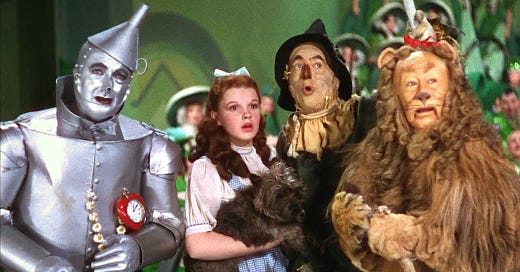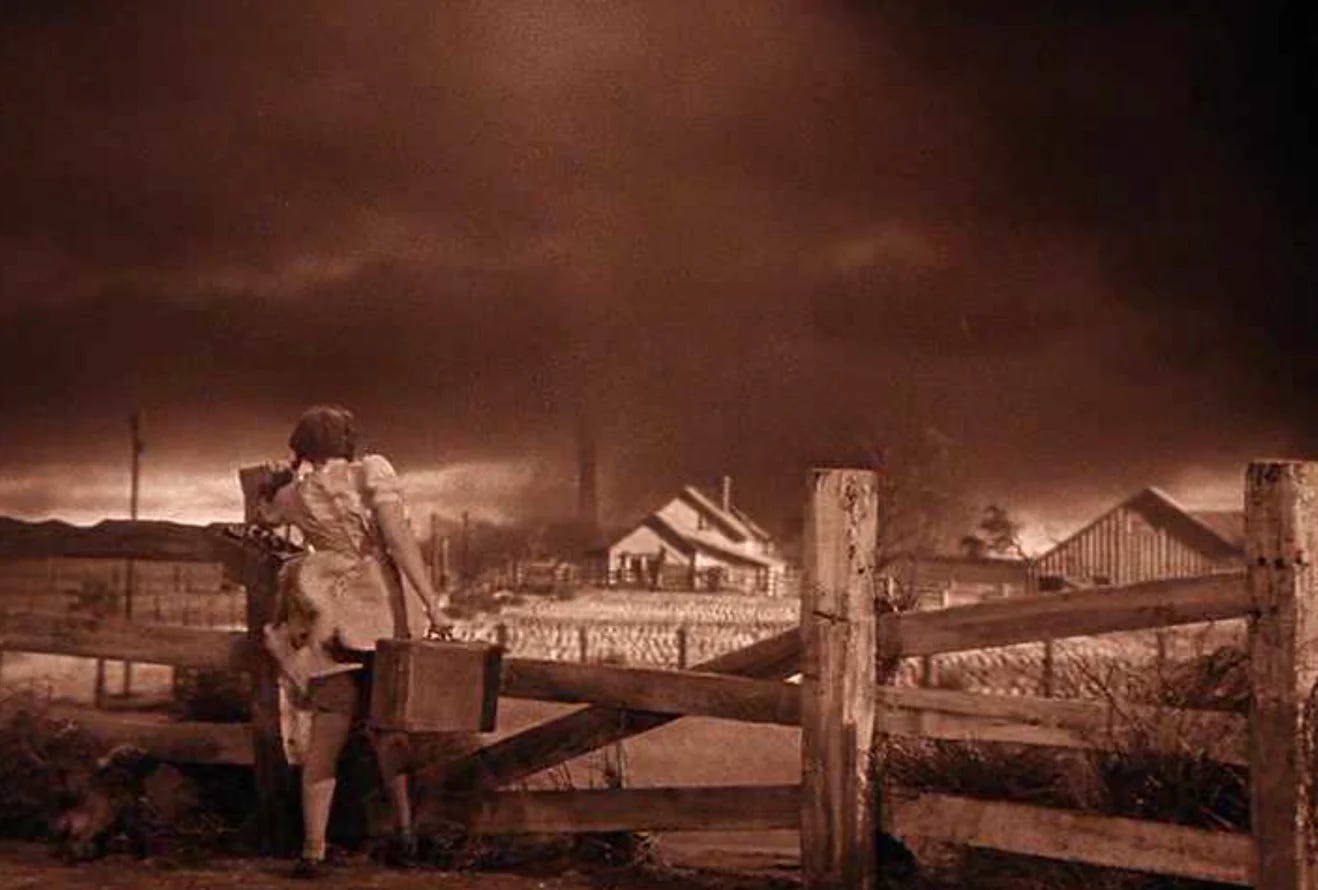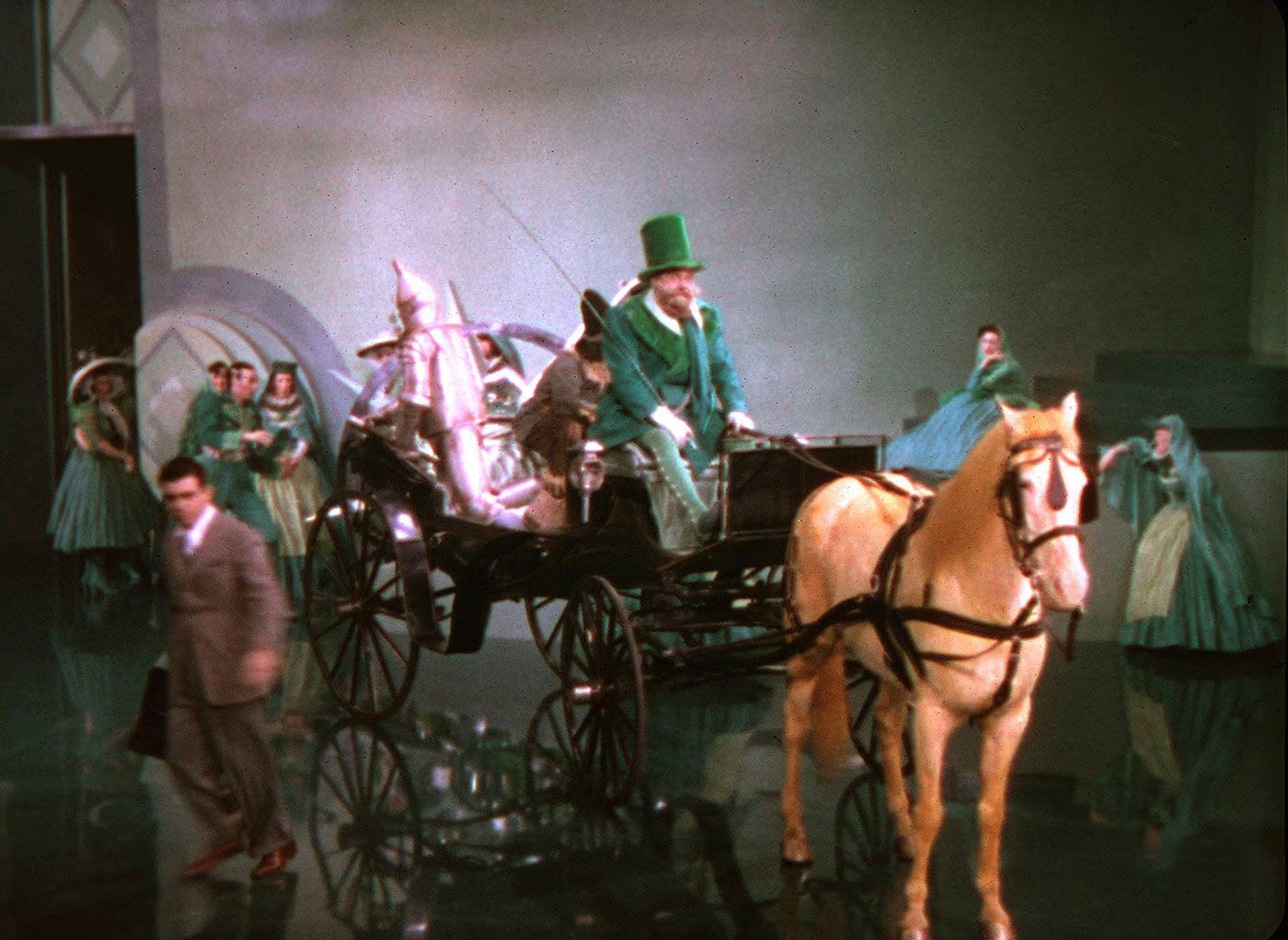The Special Effects in Oz
The rest of the world was black and white but we were in screaming colour
Some spoilers ahead for The Wizard of Oz (1939).
Picture this – it’s the 25th of August, 1939. The US is at the tail end of the Great Depression and the world is on the cusp of the Second World War. Earlier that morning, on the other side of the Atlantic Ocean, Louvre was closed under the pretence of repair work, but really, the staff worked three days and nights to transport the artwork to secret locations for safekeeping. Less than 24 hours earlier, a group of German agents attacked a rail station on the Polish-Slovak border, unaware that the invasion of Poland had been postponed, marking the first commando operation of World War II. And, amidst all that, you walk into a cinema, somewhere in New York, or California, or Kansas, to see the new MGM picture, a musical. The film opens in sepia, close enough to the standard black and white you are used to seeing on screen, but within minutes, Dorothy is transported to the Land of Oz, and so are you as the screen turns into colour.
I had the opportunity of seeing The Wizard of Oz on the big screen last month for its 85th anniversary and I haven’t been able to stop thinking about the technical aspects of the film, and what it must have been like to experience that film on its release day. Truthfully, while I was sitting in the theatre, I couldn’t even wrap my mind around how some of the special effects – no matter how silly they look to us now – were achieved at the time of production. Of course, this prompted some research in the days following my screening, and I wanted to share some of what I’ve found in this post.
Technicolour Basics
Despite what some might think, The Wizard of Oz was not the first film to have been made in Technicolour. Far from it. While Technicolour emerged as early as the 1910s, Becky Sharp (1935) was the first feature film to use the three-strip Technicolour production throughout. But even that technology was developed, and employed for the first time sooner than 1935. The way it works is that a scene is shot through a prism that splits the light into blue, red, and green negatives. Those are then soaked with the dyes of the complimentary colours and pressed onto a blank piece of film with a matrix relief, one colour at a time. The video below gives the full explanation on Technicolour’s dye-transfer printing process.
In the context of The Wizard of Oz, there were two things in particular that I found interesting when it came to its use of Technicolour:
In the scene when Dorothy first enters the Land of Oz, there is a shot, as she opens the door, where we see both her – in monochromatic sepia tone – as well as the colourful Oz through the opening door. Today, something like this would easily be achieved with a green screen and some masking. But, in The Wizard of Oz, they cleverly used Judy Garland’s body double, dressed in sepia tones to open up the world of colour, and had her swap her place with Judy Garland as Dorthy briefly gets out of the shot before stepping into the colourful world of the Land of Oz.
The lighting required for Technicolour productions requires a significant amount of light and the temperatures from the hot studio lights on set reportedly exceeded 38 °C (100 °F) with some of the actors claiming to have suffered permanent eye damage from the carbon arc illumination with its highly actinic ultraviolet. Living in the age when working conditions on sets are – for the most part – regulated, this “fun fact” is equal parts fascinating and terrifying.
The Tornado Scene
If you, like me, had a great time this summer watching Twisters (2024) in IMAX, you may have spent more time than is deemed normal thinking about tornadoes recently. The Wizard of Oz tornado scene is realistic, even by today’s standards, yet the way it was produced is so far from anything that would be employed today.
Arnold Gillespie, who worked as the film’s special effects director, hung 35 feet of muslin cloth from a steel gantry and connected it at the bottom to a rod. Moving the gantry and the rod, and spraying Fuller’s earth from both the top and the bottom using compressed air hoses, he was able to create the illusion of a moving tornado.
Throughout the scene, the tornado stays relatively far in the background, which certainly helps with selling the illusion, but even the foreground events – the wind, the dust, and the flying objects – seem realistic and were done expertly well to support the tornado the viewer is seeing in the background.
The Colourful Horses
Towards the end of the film, when Dorothy and her crew arrive in Emerald City, they end up in a carriage that’s being pulled by horses in various colours – or rather, one horse that changes colours from white to purple to red to yellow. It’s silly, really, and potentially a bit pointless in the grand scheme of things but it’s one of the special effects in the film that I really couldn’t figure out as I watched it in the theatre. It’s one of many things in this film that would be so easily achievable in modern-day editing software but seem like an impossibility to achieve without it.
It turns out that the production team used Jell-O powder to colour white horses for the scene. To go back to a point I made earlier about safety regulations on set, I am not sure where this falls on the spectrum of harmless to animal cruelty but it is visually fascinating because the horses on screen don’t look artificially coloured, they look digitally edited to my eye. I suppose some of that comes from Technicolour and its ability to really emphasise bright colours in a way that seems almost unnatural.
The (Questionable) Use of Asbestos
To wrap up this list, we have another health code violation.
Right before they reach their destination, Dorothy and her friends find themselves crossing a field of poppies in what is probably one of the most iconic scenes in the film. Dorothy briefly faints but is woken up with the help of Glinda the Good Witch. However, when she wakes, she – and the poppy field – are covered in snow. And it’s not a little bit of “snow” that they find themselves in, it’s excessive amounts.
Years after the film’s release, it was revealed that white asbestos was used as artificial snow for the scene. And horrifyingly, asbestos is very well known to cause lung inflammation, scarring within the body after inhalation, and several serious lung diseases. While it has never been confirmed that anyone from the set had health issues caused by asbestos, other toxic materials have caused issues – including the aluminium that was used in Tin Man’s makeup which hospitalised Buddy Ebsen, the original actor who was cast in the role, with poisoning. Even his replacement, Jack Haley who we all now know as Tin Man, developed a mild infection from his character’s makeup.
A Few Final Words
The production and the final product of The Wizard of Oz are undoubtedly fascinating. Technically speaking, it may very well be one of the most impressive films of all time – it certainly was at the time of its release and it’s quite sad its theatrical run got cut short with the start of the Second World War. The experience of seeing it on the big screen in its release year is something that I doubt can be replicated with re-releases. Of course, we can appreciate its technical achievements in hindsight, and I have tremendously enjoyed learning more about techniques employed before special effects were almost exclusively a digital task, but it must have been a cinema experience of a lifetime to experience this production when its technical aspects were a novelty.
References
Care, R. (1980). Two animation books: The animated raggedy Ann and Andy. John Canemaker. ; the making of The Wizard of Oz. Aljean Harmetz. Film Quarterly, 33(4), 45–47.
Jewell, R. B. (2007). The Golden Age of cinema: Hollywood, 1929-1945. Blackwell Pub.
Mueller, M. (2007). Canaris: The Life and Death of Hitler’s spymaster (G. Brooks, Trans.). Naval Institute Press.
Poirier, A. (2014, November 22). Saviour of France’s art: How the Mona Lisa was spirited away from the Nazis. The Guardian. https://www.theguardian.com/world/2014/nov/22/mona-lisa-spirited-away-from-nazis-jacques-jaujard-louvre
Rushdie, S. (1992). The Wizard of Oz. Palgrave Macmillan on behalf of the BFI.
Vox. (2017, December 1). How Technicolor changed movies [Video]. YouTube.






